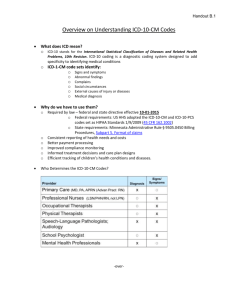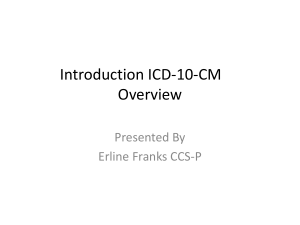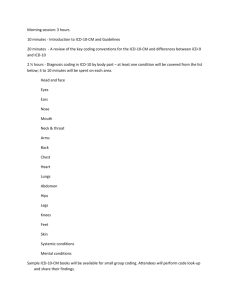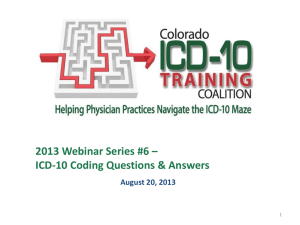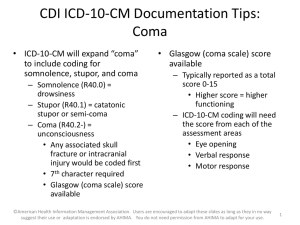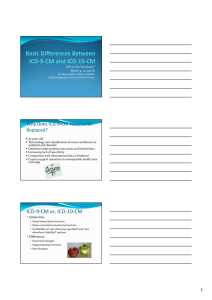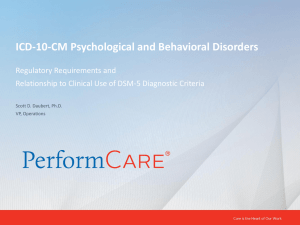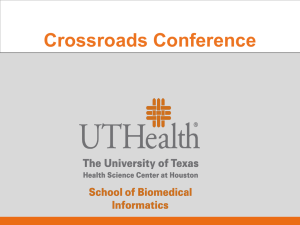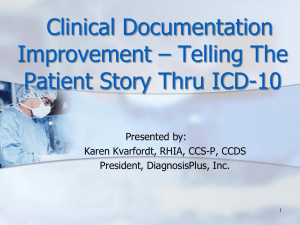A chapter by chapter look at the ICD-10-CM code set
advertisement
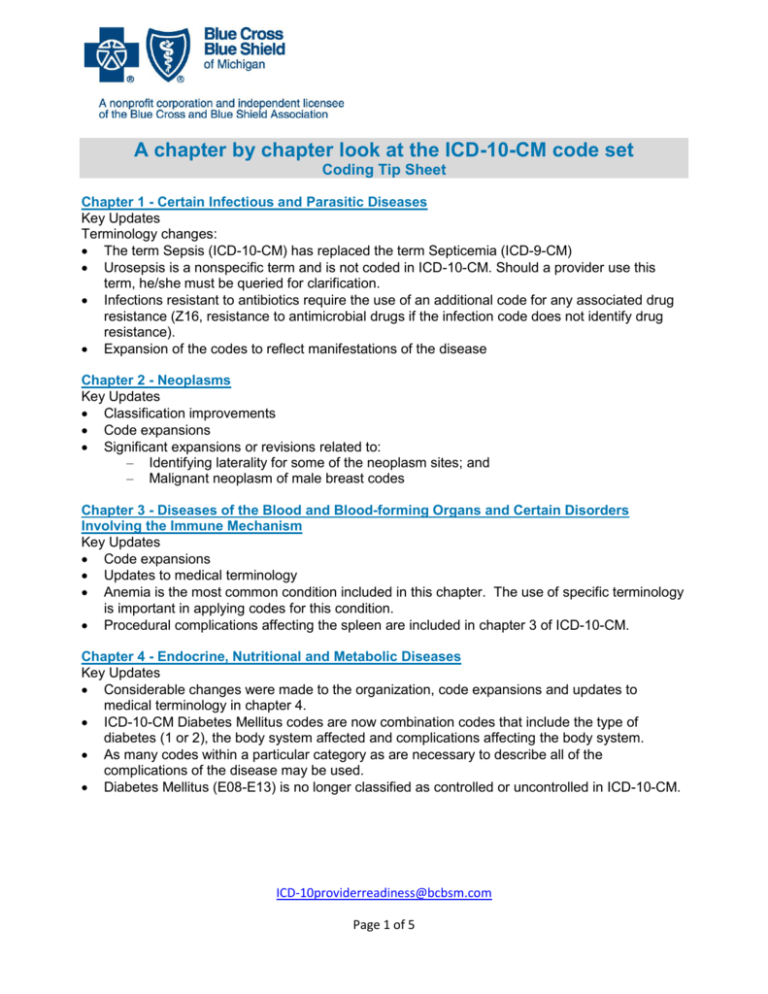
A chapter by chapter look at the ICD-10-CM code set Coding Tip Sheet Chapter 1 - Certain Infectious and Parasitic Diseases Key Updates Terminology changes: The term Sepsis (ICD-10-CM) has replaced the term Septicemia (ICD-9-CM) Urosepsis is a nonspecific term and is not coded in ICD-10-CM. Should a provider use this term, he/she must be queried for clarification. Infections resistant to antibiotics require the use of an additional code for any associated drug resistance (Z16, resistance to antimicrobial drugs if the infection code does not identify drug resistance). Expansion of the codes to reflect manifestations of the disease Chapter 2 - Neoplasms Key Updates Classification improvements Code expansions Significant expansions or revisions related to: – Identifying laterality for some of the neoplasm sites; and – Malignant neoplasm of male breast codes Chapter 3 - Diseases of the Blood and Blood-forming Organs and Certain Disorders Involving the Immune Mechanism Key Updates Code expansions Updates to medical terminology Anemia is the most common condition included in this chapter. The use of specific terminology is important in applying codes for this condition. Procedural complications affecting the spleen are included in chapter 3 of ICD-10-CM. Chapter 4 - Endocrine, Nutritional and Metabolic Diseases Key Updates Considerable changes were made to the organization, code expansions and updates to medical terminology in chapter 4. ICD-10-CM Diabetes Mellitus codes are now combination codes that include the type of diabetes (1 or 2), the body system affected and complications affecting the body system. As many codes within a particular category as are necessary to describe all of the complications of the disease may be used. Diabetes Mellitus (E08-E13) is no longer classified as controlled or uncontrolled in ICD-10-CM. ICD-10providerreadiness@bcbsm.com Page 1 of 5 A chapter by chapter look at the ICD-10-CM code set Continued Chapter 4 - Endocrine, Nutritional and Metabolic Diseases ICD-10-CM there are 5 category codes for Diabetes Mellitus: – E08 – Diabetes Mellitus due to underlying conditions – E09 - Drug or chemical induced Diabetes Mellitus – E10 – Type 1 Diabetes Mellitus – E11 - Type 2 Diabetes Mellitus – E13 - Other specified Diabetes Mellitus Overweight and obesity codes: – The classification for overweight and obesity has been expanded in ICD-10-CM to include: • Obesity due to excess calories • Morbid (severe) obesity due to excess calories • Drug induced obesity • Morbid (severe) obesity due to alveolar hypoventilation - Overweight An additional code (Z68-) is used to identify the body mass index (BMI), if known. Chapter 5 - Mental, Behavioral and Neurodevelopmental Disorders Key Updates Classification improvements (different categories) Code expansions: – Most notably, Other Isolated or Specific Phobias Updates to medical terminology: – Bipolar I disorder, single manic episode will change to manic episode. – Undersocialized conduct disorders, aggressive will become Conduct disorder childhood-onset type. Nicotine dependence updated to identify specific tobacco products (cigarettes, chewing tobacco, and other tobacco). Chapter 6 - Diseases of the Nervous System Key Updates ICD-10-CM devotes chapter 6 to Diseases of the Nervous System. The sense organs (eye/adnexa and ear/mastoid processes) have their own chapters in ICD-10-CM. Classification improvements (significant changes to sleep disorders) Code expansions (e.g. Alzheimer’s, headaches) Updates to medical terminology (epilepsy, seizures) Codes for TIA are now included in the nervous system chapter. Codes for migraine have been expanded to fifth and sixth characters to indicate if the migraine is intractable and to provide additional specificity within the code description. Chapter 7 - Diseases of the Eye and Adnexa Key Updates Diseases of the Eye and Adnexa is a new chapter in ICD-10-CM which has been separated from the Nervous System and Sense Organs chapter included in ICD-9-CM. Terminology improvements (bringing terms up to date) Revisions to identify laterality: – Many of the codes have laterality designation and, in some instances bilateral designation for diseases of the eye. – A code for unspecified site is also provided should the site not be identified in the medical record. ICD-10providerreadiness@bcbsm.com Page 2 of 5 A chapter by chapter look at the ICD-10-CM code set Continued Chapter 8 - Diseases of the Ear and Mastoid process Key Updates Diseases of the Ear and Mastoid process is a new chapter in ICD-10-CM, which has been separated from the Nervous System and Sense Organs chapter included in ICD-9-CM. There is greater specificity and detail in the codes. Many of the codes have laterality designation. Chapter 9 - Diseases of the Circulatory System Key Updates A new category has been added for coding a subsequent acute MI, which is an MI that occurs within 28 days of a previous acute MI. The time frame for assigning the acute MI code is 28 days in ICD-10-CM. Terminology used to describe several cardiovascular conditions has been revised to reflect more current medical practice. A major change is the classification of hypertension, which in ICD-9-CM was classified by type: – Benign, Malignant or Unspecified. That classification is not required in ICD-10-CM because there is only one code for hypertension in ICD-10; the code is I10 - Essential (Primary) Hypertension. Chapter 10 - Diseases of the Respiratory System Key Updates Modifications have been made to specific categories that bring the terminology up-to-date with current medical practice. – Emphysema now contains codes with panlobular and centrilobular in their description. – Asthma is now classified as mild intermittent, mild persistent, moderate persistent and severe persistent. Specificity increased for diseases like influenza, acute bronchitis. Coding notes updated to require the coder to include information about tobacco use/dependence, where applicable. Procedural complications that affect the respiratory system are now included in this chapter in ICD-10-CM. Chapter 11 - Diseases of the Digestive System Key Updates A number of new subcategories have been added to this chapter. Codes for Crohn’s disease have been expanded to specify site, if a complication is present, and what that complication is. Some terminology changes and revisions to the classification of specific digestive conditions have occurred in ICD-10-CM as well. – The term hemorrhage is used when referring to ulcers. – Hernia categories include laterality and recurrence. – The term bleeding is used when classifying gastritis, duodenitis, diverticulosis and diverticulitis. Chapter 12 - Diseases of the Skin and Subcutaneous Tissue Key Updates ICD-10-CM introduces a new term of “androgenic alopecia”. Pressure ulcer codes are combination codes that identify the site and stage of the ulcer. Procedural complications of the skin and subcutaneous tissue are included in chapter 12. ICD-10providerreadiness@bcbsm.com Page 3 of 5 A chapter by chapter look at the ICD-10-CM code set Continued Chapter 13 - Diseases of the Musculoskeletal System and Connective Tissue Key Updates Most of the codes within this chapter have site and laterality designations. For some conditions where more than one bone, joint or muscle is usually involved, such as osteoarthritis, there is a “multiple sites” code available. Many musculoskeletal conditions are a result of previous injury or trauma to a site, or are recurrent conditions. Bone, joint or muscle conditions that are the result of a healed injury are usually found in chapter 13. – ICD-10-CM identifies three different causes for pathological fractures: Neoplastic disease, Osteoporosis, and other specified disease. – ICD-10-CM introduces the 7th character that describes type of encounter, or the state of a fractures’ healing and any sequelae. Some codes in this chapter will have the 7th character applied. Chapter 14 - Diseases of the Genitourinary System Key Updates Procedural complications affecting the genitourinary system are included in chapter 14. In some of the categories specificity is based on the gender of the patient. Laterality is used to identify conditions under N60 category, benign mammary dysplasia. Chapter 15 - Pregnancy, Childbirth and the Puerperium Key Updates The final character in most codes in this chapter indicates trimester of pregnancy, rather than the current episode of care as in ICD-9-CM. Trimesters are defined as: – First trimester – less than 14 weeks 0 days – Second trimester – 14 weeks 0 days to less than 28 weeks 0 days – Third trimester – 28 weeks 0 days until delivery Supervision of care for high-risk pregnancy is now classified to this chapter. Chapter 16 - Certain Conditions Originating in the Perinatal Period Key Updates Different codes are used for “light for gestational age” and “small for gestational age”. Codes for assigning birth trauma have been expanded to include more specificity. Chapter 17 - Congenital Malformations, Deformations and Chromosomal Abnormalities Key Updates • Modifications have been made to specific categories that bring the terminology up-to-date with current medical practice. • Codes have been expanded to include more specificity. Chapter 18 - Symptoms, Signs and Abnormal Clinical and Laboratory Findings Key Updates Repeated falls are coded to a symptom code in ICD-10-CM (was a V code in ICD-9-CM). There are codes to identify a patient’s coma scale. Systemic inflammatory response syndrome (SIRS) due to noninfectious process is moved from the Injury and Poisoning ICD-9-CM chapter to this ICD-10-CM chapter. ICD-10providerreadiness@bcbsm.com Page 4 of 5 A chapter by chapter look at the ICD-10-CM code set Continued Chapter 19 - Injury, Poisoning, and Certain Other Consequences of External Causes Key Updates Injuries are grouped by body part rather than category of injury as they were in ICD-9-CM. Laterality is specified in this chapter. ICD-10-CM introduces a 7th character requirement that describes the type of encounter. Most categories in this chapter use the 7th character requirement. Most categories in this chapter (see below for fractures) have three 7th character values of: A - Initial encounter D - Subsequent encounter S - Sequela For traumatic fractures, there are additional 7th character requirements depending upon the type of fracture, and complication. Some of these character descriptions are based on the Gustilo open fracture classification. Codes for underdosing are new in ICD-10-CM. Underdosing refers to taking less of a medication than is prescribed by a provider or less than the manufacturer’s instructions. Codes for underdosing should not be assigned as principal or first-listed codes. Chapter 20 - External Causes of Morbidity Key Updates External cause codes are intended to provide data for injury research and evaluation of injury prevention strategies. These codes capture how the injury or health condition was caused, the intent, the place where the event occurred, the activity of the patient at the time of the event, and the person’s status. These codes are secondary codes for use in any health care setting and are not used as a principal (or first-listed) diagnosis. There is no national requirement for mandatory ICD-10-CM external cause code reporting. Unless a provider is subject to a state-based external cause code reporting mandate or these codes are required by a particular payer, reporting ICD-10-CM codes in Chapter 20 is not required. In the absence of a mandatory reporting requirement, providers are encouraged to voluntarily report external cause codes, as they provide valuable data for injury research and evaluation of injury prevention strategies. Chapter 21 - Factors Influencing Health Status and Contact with Health Services Key Updates These codes are used in any healthcare setting. Z codes may be used as either a first- listed or principal diagnosis code in the inpatient setting, or secondary code, depending on the circumstances of the encounter. Certain Z codes may only be used as first- listed or principal diagnosis in certain situations. Refer to Official Coding Guidelines for details. Z codes are not procedure codes. A corresponding procedure code must accompany a Z code to describe any procedure performed. (Source: 2014 Draft ICD-10-CM Official Guidelines for Coding and Reporting) The information in this document is not intended to impart legal advice. This overview is intended as an educational tool only and should not be relied upon as legal or compliance advice. If you have any legal questions about the information contained herein, you should consult your attorney or other professional legal services provider. ICD-10providerreadiness@bcbsm.com Page 5 of 5
